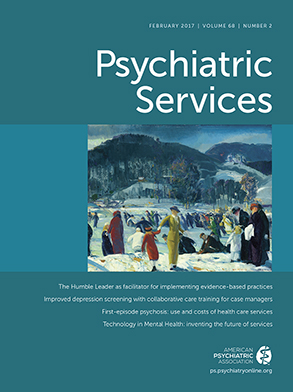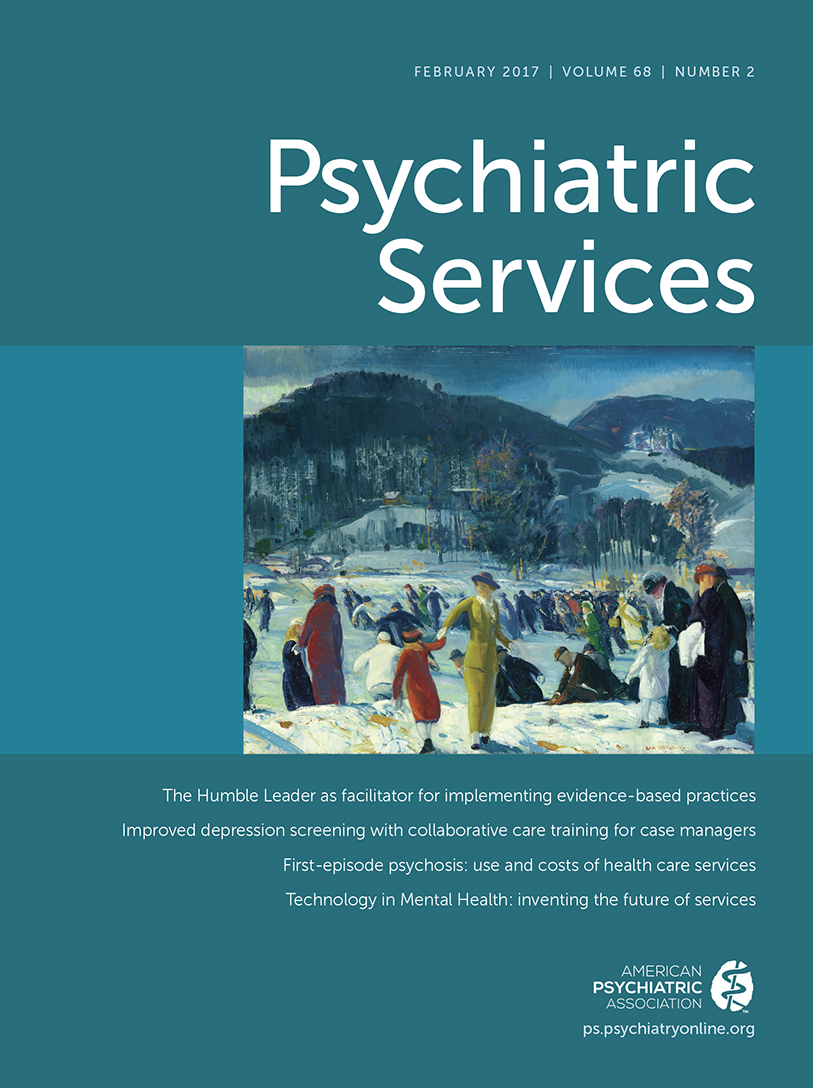Antidepressant medication is the most frequently used treatment modality for major depressive disorder (MDD) (
1). Best-practice guidelines for the recognition and treatment of MDD have been established to help health care professionals provide adequate and effective treatment. The American Psychiatric Association (APA) has developed specific treatment guidelines for clinicians to consider when making diagnoses and treating patients for MDD, which include recommended dosing guidelines for antidepressant medications and treatment guidelines for psychotherapy and other therapies (such as electroconvulsive therapy) (
2). The guidelines of the Centers for Medicare and Medicaid Services (CMS) are less extensive than the APA guidelines and focus mostly on recommended dosing of antidepressant medication (
3). In addition, the Antidepressant Treatment History Form (ATHF), which is commonly used in clinical research to assess a patient’s treatment history, provides specific dosing guidelines for antidepressant medication. The ATHF dosing guidelines were established to determine whether patients who fail to respond to an antidepressant medication actually received an adequate dose and duration of the medication (
4,
5). As a result, this measure outlines the minimum effective dose for all antidepressant medications.
Although these treatment guidelines have been established and are frequently cited in the literature, to date few studies have evaluated the actual prescribing practices of health care providers within clinical practice to determine whether and how antidepressant dosing differs from established treatment guidelines. The purpose of this study was to examine the application of established treatment guidelines in clinical practice by describing the prescribing practices of clinicians for patients with MDD. This study examined the most frequently prescribed antidepressants, as well as the most common dosage of these medications, for the treatment of MDD in a population with health insurance.
Methods
An observational, retrospective analysis was conducted. Participants were identified from an administrative claims database of a large health care company that insured nearly 12 million people, over 5 million with Medicare coverage, in 2013 (
6). The database included medical and prescription claims filed by the patient’s health care provider, as well as patient demographic information.
Patients were included in this analysis if they were 18 years of age or older, lived in the United States, and had a claim for MDD. MDD diagnosis was identified from medical claims between January 1, 2013, and December 31, 2013 (study period), that indicated a diagnosis of MDD (ICD-9-CM codes 296.2, 296.3, and 311) among the top six diagnostic codes in the claims from the database. Patients were also required to have been enrolled in an insurance plan with continuous insurance coverage (Medicare, Medicaid, commercial, or other) from the same health care company during the study period. This analysis was conducted as part of normal operational efforts to improve quality and thus did not meet the Department of Health and Human Service’s regulatory definition of research under the Code of Federal Regulations.
This was a medication count-level analysis based on the study population’s antidepressant medication history (specifically, count, type, and dosage) during 2013. Antidepressant medications were identified as antidepressant medication by the National Drug Code. The percentages of patients with a prescription for each drug and drug class were calculated along with the dosage frequencies. Percentages for prescribed drug and drug class for each medication were based on the medication count and the total sample of patients with MDD (denominator). Percentages for the common dosage were based on the medication count of the dosage and the total sample of patients on that drug. If a patient had several claims filed for the same antidepressant medication, the medication was counted only once for that patient. Patients could have been prescribed more than one antidepressant medication or been prescribed multiple doses of the same medication during the study period, or both. If a patient had a change in dosage for the same drug, this was counted as a separate medication for that patient.
Results
Of the patients who had an MDD diagnosis (N=68,394), 14,287 were excluded because they did not have an antidepressant medication filled during the study period. The study sample (N=54,107) was predominantly female (N=39,816, 73.6%) and covered by a Medicare plan (N=48,266, 89.2%), and most patients resided in the South Atlantic region of the United States (N=24,439, 45.2%). The mean±SD age of the patient sample was 66.8±12.7. Patients were prescribed 2.6±1.7 antidepressant medications.
The most commonly prescribed drug classes, from most prescribed to least prescribed, were selective serotonin reuptake inhibitors (SSRIs, N=42,263, 78.1%), serotonin-norepinephrine reuptake inhibitors (SNRIs, N=14,155, 26.2%), serotonin antagonist and reuptake inhibitors (SARIs, N=9,592, 17.7%), norepinephrine-dopamine reuptake inhibitors (NDRIs, N=8,479, 15.7%), tricyclic antidepressants (TCAs, N=5,184, 9.6%), tetracyclic antidepressants (TeCAs, N=4,345, 8.0%), and monoamine oxidase inhibitors (MAOIs, N=64, .1%). The most commonly prescribed antidepressant medications, most common daily dose, and related APA, CMS, and ATHF dosing guidelines for the medications are presented in
Table 1.
Based on the most frequently prescribed dosage for each medication, amitriptyline, doxepin, imipramine, and nortriptyline did not meet the recommended guidelines of the APA, CMS, or the ATHF (
Table 1). Fluvoxamine, sertraline, clomipramine, desipramine, maprotiline, protriptyline, trimipramine, phenelzine, selegiline, venlafaxine, amoxapine, mirtazapine, and trazodone did not meet ATHF guidelines, although for fluvoxamine and clomipramine, ATHF guidelines were the only guidelines available for comparison.
Discussion
This study is the first of its kind to report the prescribing practices for antidepressant medications in a large population of patients with MDD and how these practices compare with established dosing guidelines issued by the APA and CMS and specified in the ATHF. Previous studies have highlighted prescribing practices at the drug class level and have not examined antidepressant use to the detailed level of specific drug or dosage, nor compared those results with existing treatment guidelines (
1,
7).
The most frequently prescribed dosages for each drug fell within the APA and CMS guidelines, with the exception of trazodone, amitriptyline, clomipramine, doxepin, imipramine, and nortriptyline. The drugs that did not meet the minimally effective dose outlined by the ATHF included venlafaxine, trazodone, some of the older SSRIs (including fluvoxamine and sertraline), all of the TCA and TeCA drugs, and selected MAOIs (including phenelzine and selegiline).
There are several reasons why certain drugs may have been prescribed at lower-than-recommended doses. Of the antidepressant medications examined, 100 mg of trazadone was one of the most frequently prescribed drugs, and it did not meet the recommended guidelines of APA, CMS, or ATHF (150 mg of trazodone). Trazodone is approved by the U.S. Food and Drug Administration for the treatment of depression. However, trazodone is more commonly prescribed off label as a sleep aid at lower doses (specifically, 100 mg) for patients with depression, given its effectiveness in improving sleep quality among patients with depression (
8). On the basis of results of our study, it is possible that trazodone was being used as a sleep aid for patients with MDD who had persistent sleep disturbance symptoms rather than being used to treat MDD.
The most frequent dosages of the TCA and TeCA medications, as well as some of the MAOI medications, were lower than the recommended minimally effective dose described by the ATHF. There are several possible explanations for why these drugs were dosed lower than recommended by the ATHF. TCAs and TeCAs may be prescribed at lower dosages because of their increased toxicity and corresponding risk of overdose. Because TCAs have a narrower therapeutic index than other antidepressants, this class of antidepressants has a greater potential for lethality after an intentional overdose (
9). Less experience of physicians on effective TCA and TeCA dosing, partly due to a decline in prescribing of these medications, may also explain the lower doses shown in the results (
10). TCAs are also commonly used in off-label situations for treatment of insomnia and neuropathic pain, which are commonly prescribed at lower doses for these conditions compared with depression treatment (
11,
12). MAOI medications may be dosed lower because of the dietary limitations required by taking these medications. The ATHF is used to identify treatment resistance for patients with a diagnosis of MDD and therefore has more aggressive recommendations for dosing (
4,
5). The side effects of, and physician experience with, dosing of these medications, as well as the aggressive dosing recommendations by the ATHF, could explain why patients in this study did not meet ATHF dosing recommendations. It is also important to note that the study did not include data on titration dosing. It is also possible that low dosing was indicated by a titration plan (that is, a patient may have started at a low dose but eventually titrated up to a dose within recommended guidelines).
An incidental finding from the study sample derivation was that approximately 80% of patients who were diagnosed as having MDD filled an antidepressant medication within the study period. This finding is consistent with national trends reported in the literature—that 73.8% of patients with MDD were receiving antidepressant medication in 1998 and 75.3% were in 2007 (
1). A possible explanation for why patients did not receive antidepressant medication during the study period could be that their treatment was managed with a different treatment modality—for example, psychotherapy. The literature shows that 43% of U.S. patients with MDD received psychotherapy in 2007 (
1). In addition, patient preference may have influenced whether treatment was accessed or what type of treatment was received. One study reported that 83% of patients diagnosed as having MDD were interested in receiving treatment, and of those interested in receiving treatment, the preference for treatment was for counseling over medication (
13).
Some study limitations may limit generalizability of the results. For example, this study included only insured members who had continuous insurance coverage with the health care company. These results may not be applicable to patients who are uninsured or to those with intermittent coverage. In addition, the population consisted mostly of Medicare members over age 65. Because of the increased rates of comorbid chronic medical conditions in this population, antidepressant medications are likely to have been limited to those that do not interfere with other medications. These results reflect prescription claims data and do not include medications that were prescribed but not filled, nor do they indicate whether prescriptions were new or for maintenance.
Additional limitations may have influenced prescribing patterns. The observational analysis did not control for provider or insurance plan type. Primary care physicians (PCPs) are less likely than psychiatrists to prescribe TCAs (
14). PCPs may have misdiagnosed MDD due to their limited time or training and could have prescribed lower doses of antidepressant medications compared with psychiatrists (
15). The pay structure or formulary limitations of the participant’s insurance plan may have also influenced which antidepressant medications were prescribed to the patient. It is also important to note that the results do not include duration of antidepressant treatment. It is unknown whether a patient’s treatment was concordant with guidelines just once or consistently over time.
Future research should examine variables such as insurance plan, payment structure, co-occurring medical conditions, age of patient, and prescriber type and their influence on antidepressant medication prescribing practices for patients diagnosed as having MDD.

